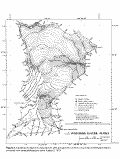Wolverine Glacier, Alaska -
Meteorological Station Information
Introduction
This web site presents air temperature and precipitation-catch measurements recorded at
Wolverine Glacier basin from 1967 through 1995 hydrologic years (October 1 through
September 30), as part of a long-term glacier-monitoring program. The data set is 95
percent complete. This data set is important because it provides the only high-altitude,
long-term, year-round climate data for the mountains of south-central Alaska.
Wolverine Glacier is located on the Kenai Peninsula in south-central Alaska. The glacier
is one of three long-term glacier-monitoring sites operated by the U.S. Geological Survey.
The other glacier-monitoring sites are Gulkana Glacier in the Alaska Range and South
Cascade Glacier in Washington. Climate, glacier-motion, mass-balance, and stream
runoff-data are recorded at these three sites to develop a better understanding of
glacier-related hydrologic processes.
Instrument Site and Climate Description
The Wolverine climate station (lat 60°23'N., long 148°55'W.) is located at an
altitude of 990 meters (m) on the crest of a tundra vegetated glacial moraine along the
western boundary of the basin. The station is slightly lower than the glacier's average
equilibrium line altitude and approximately 500 m from the west edge of the glacier. The
average annual air temperature at the recorder site is about -1.0 degree Celsius(°C), and
the average annual precipitation-gage catch is about 1,100 millimeters (mm). Snowfall is
the dominant form of precipitation and usually accumulates on the glacier from September
through mid-June. Daily average temperatures range from a low of -25°C to a high of
15°C. Daily precipitation catch ranges from a low of zero to a high of approximately 110
mm.
Data Collection and Equipment
Weather station equipment consists of an air temperature sensor in a vented shelter, a
precipitation gage with a windshield and steel storage tank, and an analog strip-chart
recorder mounted inside a shelter on the storage tank. The meteorological equipment has
remained essentially the same since the station began operation in 1967. Installation and
testing of digital climate-recording equipment designed for satellite data telemetry began
in August of 1997 and is in progress.
Data Accuracy
The daily average temperatures have an accuracy of about ±1.0°C (Mayo, March, and
Trabant, 1992; Kennedy,
1995). The daily precipitation catch has an estimated accuracy of
about ±0.005 m (Kennedy, 1995). Analysis of published 1967 through 1977 stream flow and
glacier mass balance data by Mayo and others (1992) indicates that recorded annual
precipitation catch represents approximately 33 percent of actual annual basin
precipitation. Despite the uncertain catch efficiency, the recorded precipitation-gage
catch is a useful indicator of when and relatively how much precipitation occurs in the
basin.
Data
Near real-time
15-minute values via GOES satellite telemetry (for last 14 days, adjustable up to 31 days)
Recent daily
values data (for last 2 months, adjustable up to 24 months)
3-glacier summary of
annual, winter, and summer temperatures for period of record.
Two summary data files are included. Monthly and annual air temperature data and
monthly and annual precipitation-catch data. Air temperature values are reported in
degrees Celsius. Precipitation-catch values are reported in millimeters. These data are
formatted in rows by hydrologic year. Data are available on-line in HTML and Excel version
4.0 formats.
Monthly air temperature (HTML) 27KB
Monthly air temperature (Excel ver. 4.0) 9KB
Monthly summary of precipitation (HTML) 29KB
Monthly summary of precipitation (Excel ver. 4.0) 12KB
These climate data through 1994 are also available as a published report by
Kennedy (1995).
Data for 1995 are published in report by
Mayo and others (2004).
Maps and Photos
Basin
Map
click on thumbnail for
full image (105 KB) |
 |
|
|
Photograph
of station
click on thumbnail for
full image (35 KB) |
 |
References Cited
Kennedy, B.W., 1995, Air temperature and precipitation data, Wolverine Glacier Basin,
Alaska, 1967-94: U.S. Geological Survey Open-File Report 95-444, 79 p. and diskette.
Mayo, L.R., March, R.S., and Trabant, D.C., 1992, Air temperature and precipitation
data, 1967-88, Wolverine Glacier basin, Alaska: U.S. Open-File Report 91-246, 80 p.
Maintainer: Rod March
Last update:
Friday, July 09, 2004 02:38 PM
URL: http://ak.water.usgs.gov/glaciology/wolverine/met/stationinfo.htm |
